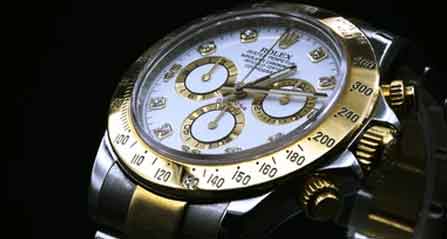Wrist watches were first introduced in the late 1800s by Patek Philippe. Now nothing can turn back the clock to the days before people were able to tell the time by a quick glance at their wrist. Today’s selection of wrist watches ranges from classic mechanical models crafted in Switzerland to high tech digital models which may include altimeters, address books, or even cameras.
Wrist watches were used extensively in combat for the first time in the Boer War in South Africa. Soldiers in World War I were issued wrist watches for quick access to the time in intense combat situations. Such was the grip held by pocket watches on men’s time telling that wrist watches were not widely adopted for daily use until the 1920s.
Soon wrist watches became a standard accessory for people who made good use of their time. Bulova made a giant leap forward with the introduction of the first fully electronic wristwatch, the Accutron, in 1960. Quartz movement watches came along in the late ’60s and again revolutionized the world of watches with greatly enhanced accuracy, discover more here.
Today’s Wrist Watches

Wrist watches are now available in every shape, size, material, and price imaginable. Some popular models include diver watches, ladies’ dress watches, and chronograph watches for split-second timing. The latest evolution in watches is their availability for great prices on the Internet.
Rolex Watch Bands
Most astute collectors of timepieces can spot a Rolex watch simply by its band. Bands and bracelets on every Rolex are crafted for both durability and appearance. This is crucial, because many of the models are designed to be worn by adventurers such as mountain climbers and divers who regularly do battle with the elements, and then wear their watches out for a night on the town. It is the strength of the bands and the overall accuracy of the watches that have elevated Rolex above most other makers of fine watches in the world.
Regardless of what type of Rolex band a person has, he can have it treated from time to time to keep it in tip-top shape. Once a band is taken apart and its pins are replaced, it will regain the look that it had when it was brand new. Also, spacing between links will be reduced, and the watch will fit perfectly again. This service is not necessary for everyone, but for those who actively wear their Rolexes, it can be beneficial.
Types of Rolex Bands

The jubilee band is one of the most popular styles. It basically features three columns of links. The two strands on the side are often made of steel, while the middle is made of gold. The jubilee can also be found in all gold, and steel and platinum. The oyster band is present on all watches in the Oyster Collection. This band is usually around seven inches long end-to-end when the clap is closed, but there are, of course, different sizes available. This band often features six removable links, as well. The oyster band utilizes screws instead of the pushpins that are used in many watches.
It is possible to find a number of different watchband clasps. Most Rolex clasps are made of stainless steel. There are fold-over clasps, drivers’ clasps, and many more. It is also possible to purchase a Rolex band with a hidden clasp.
